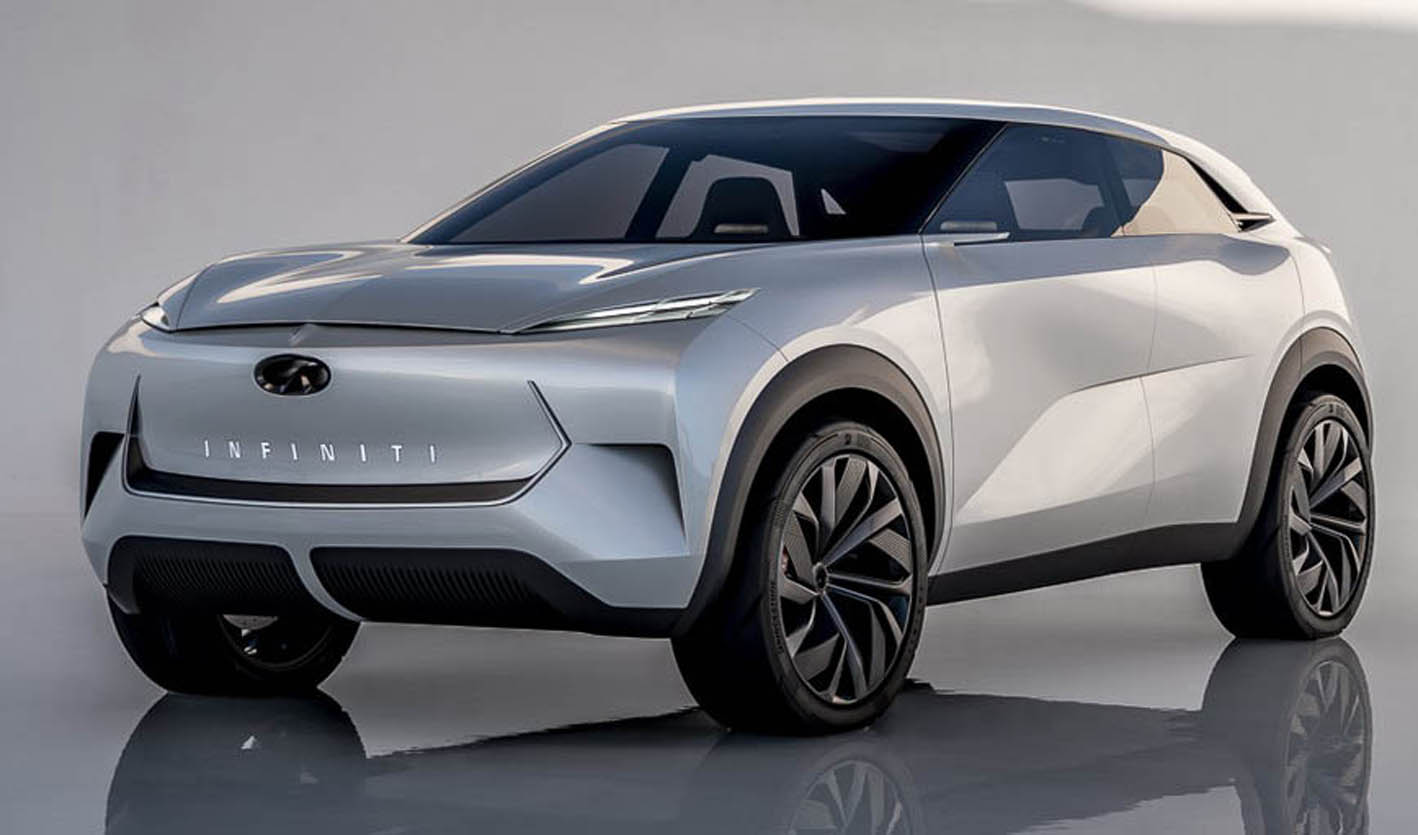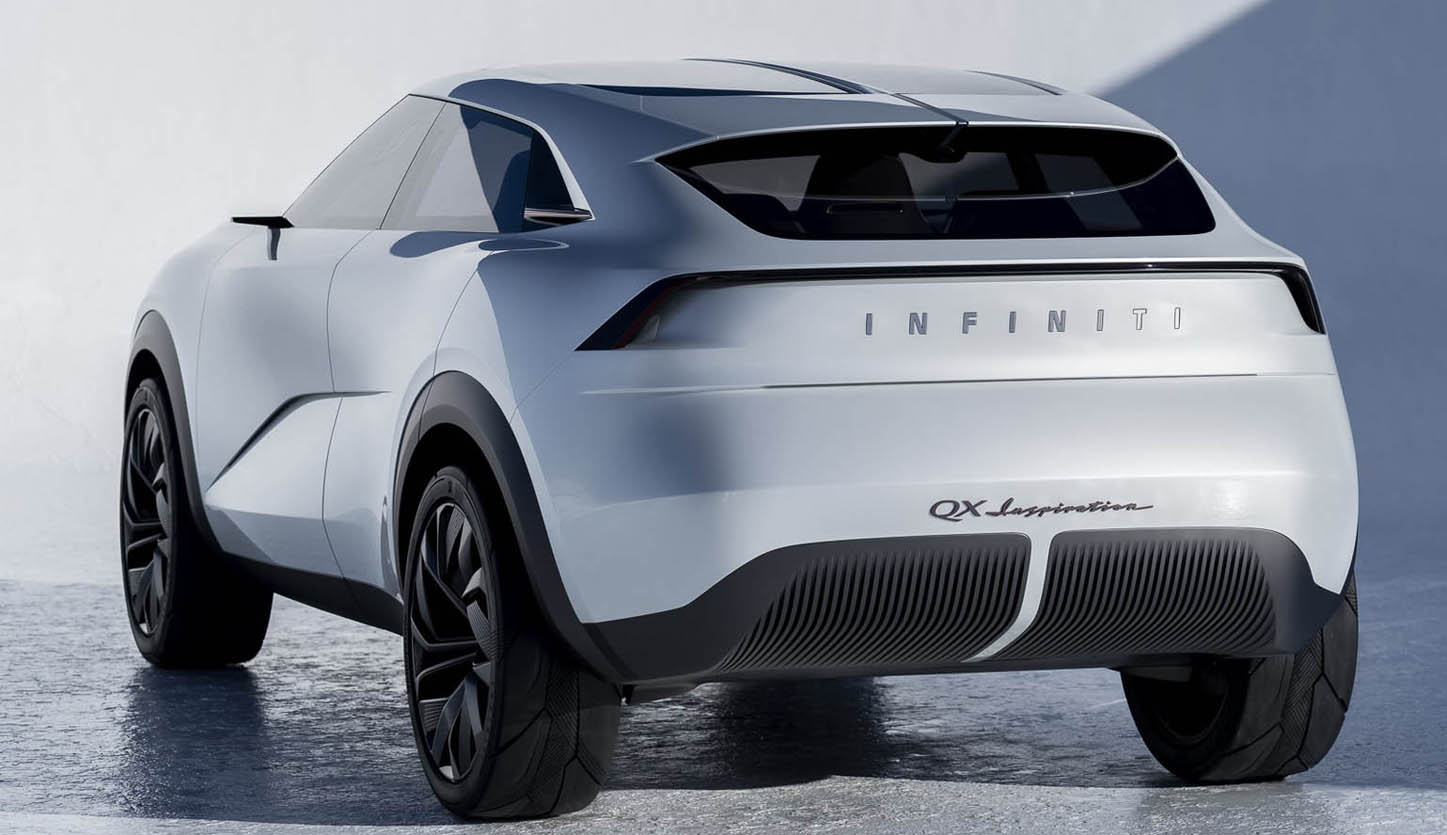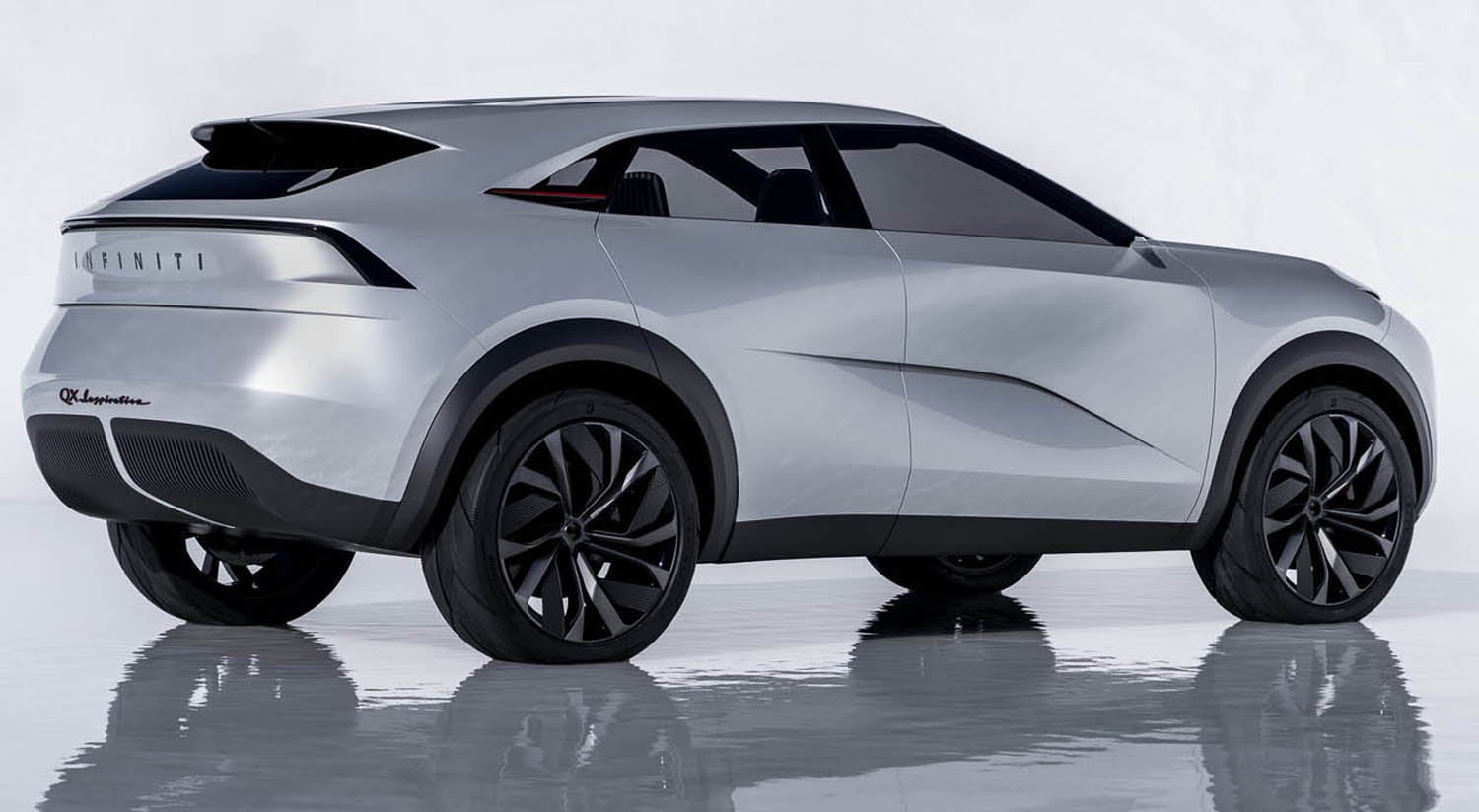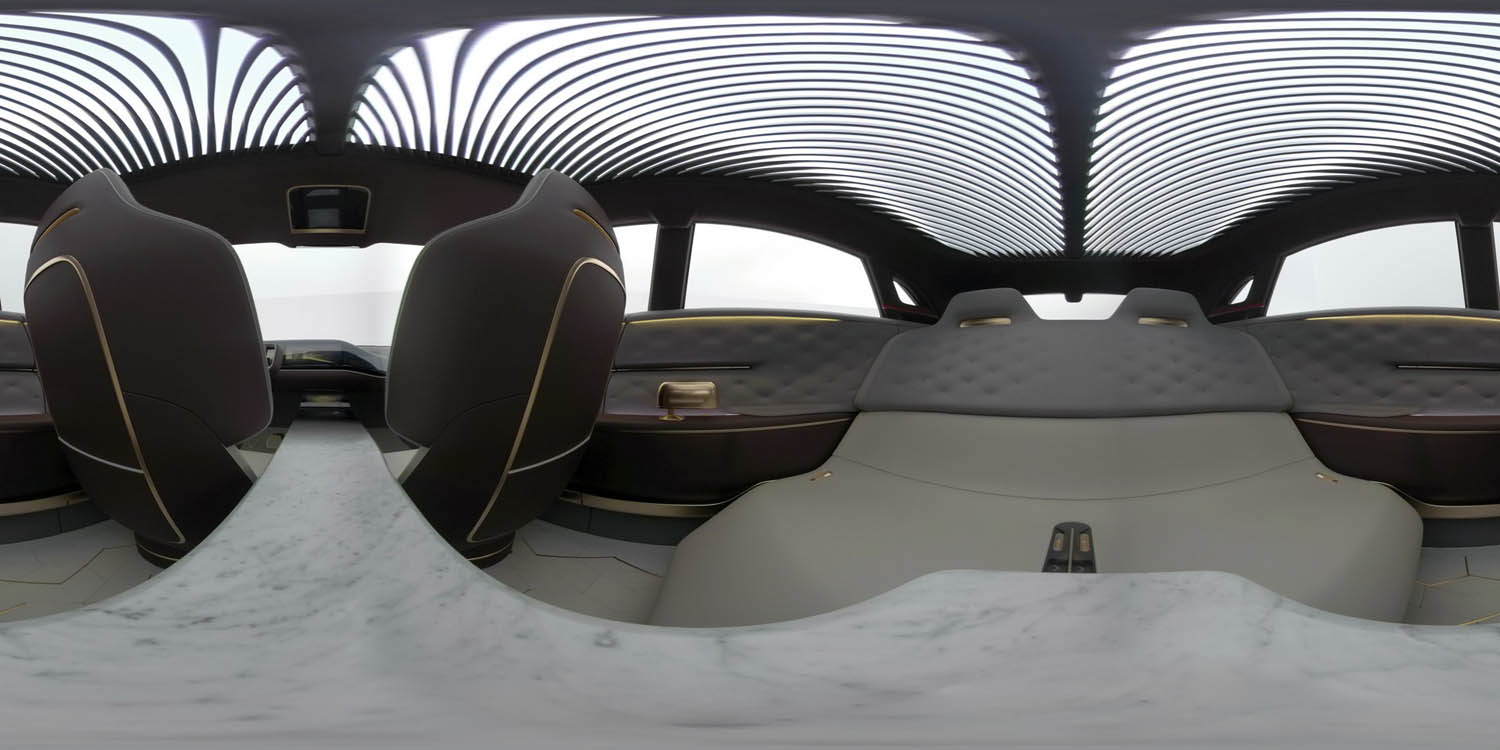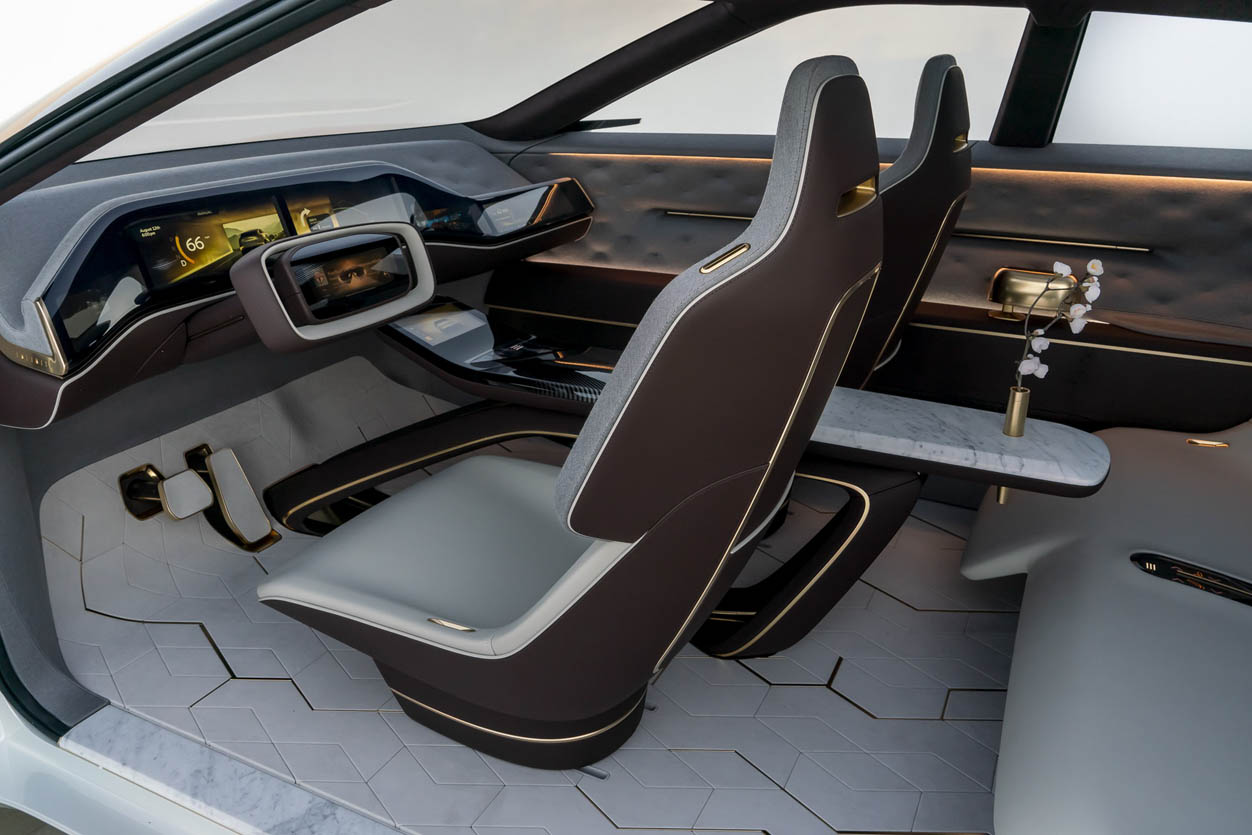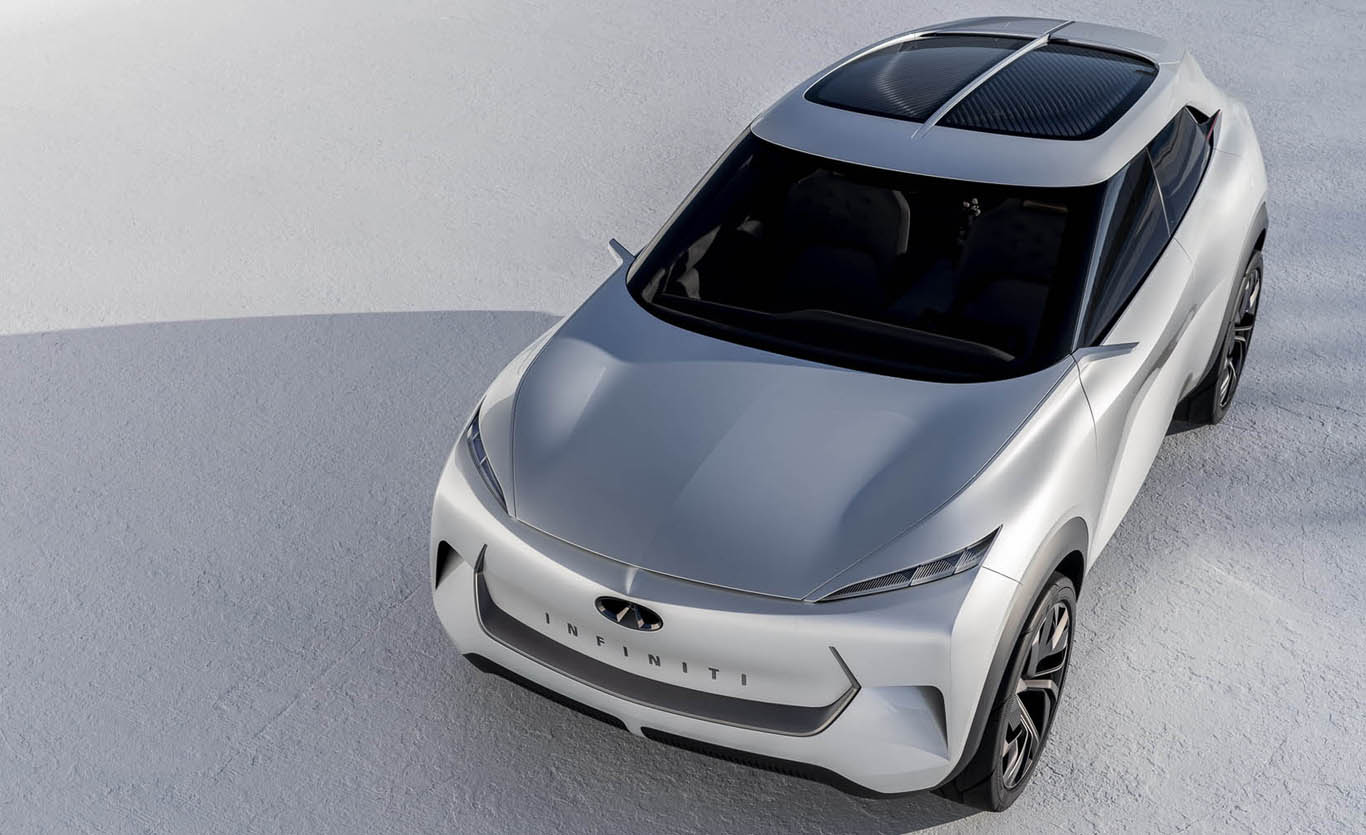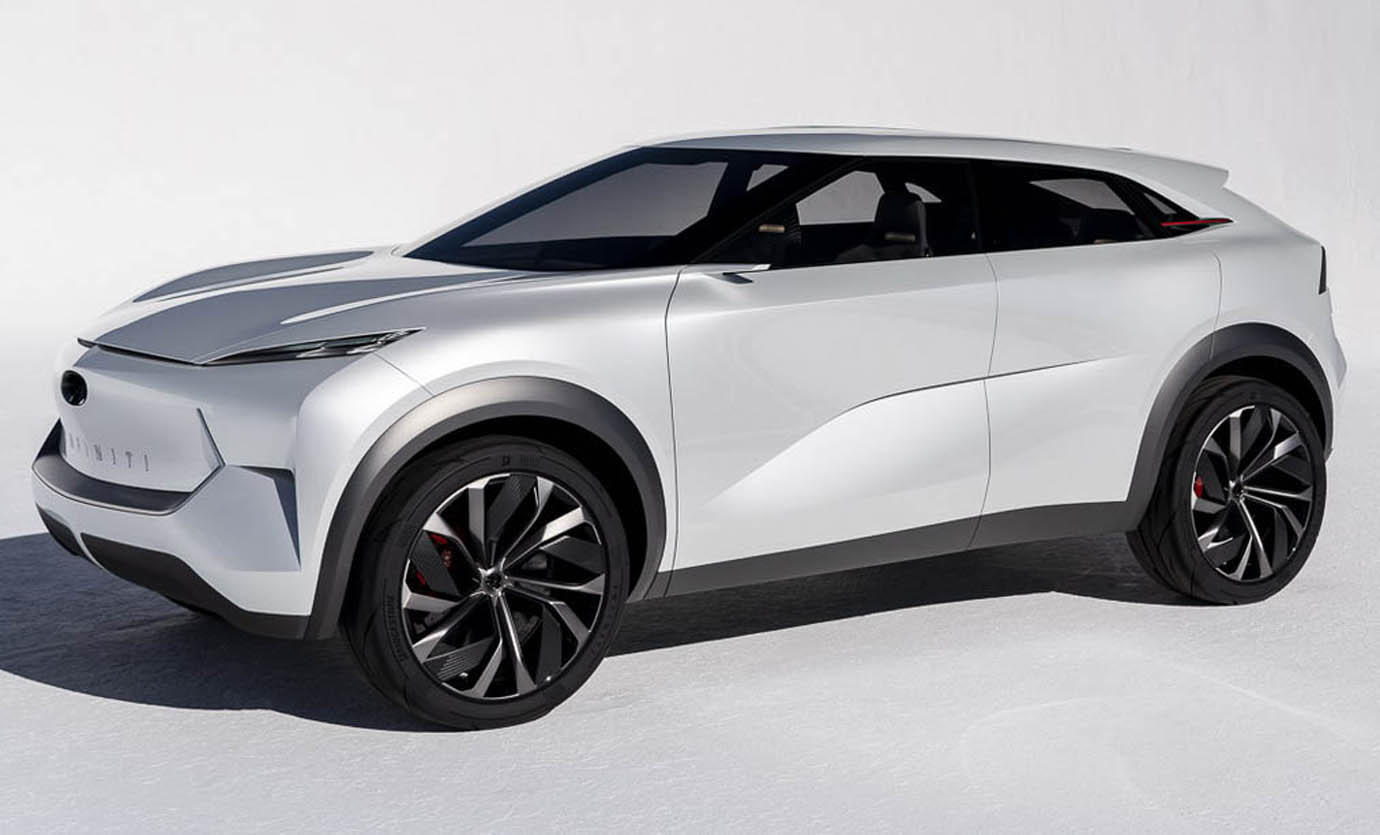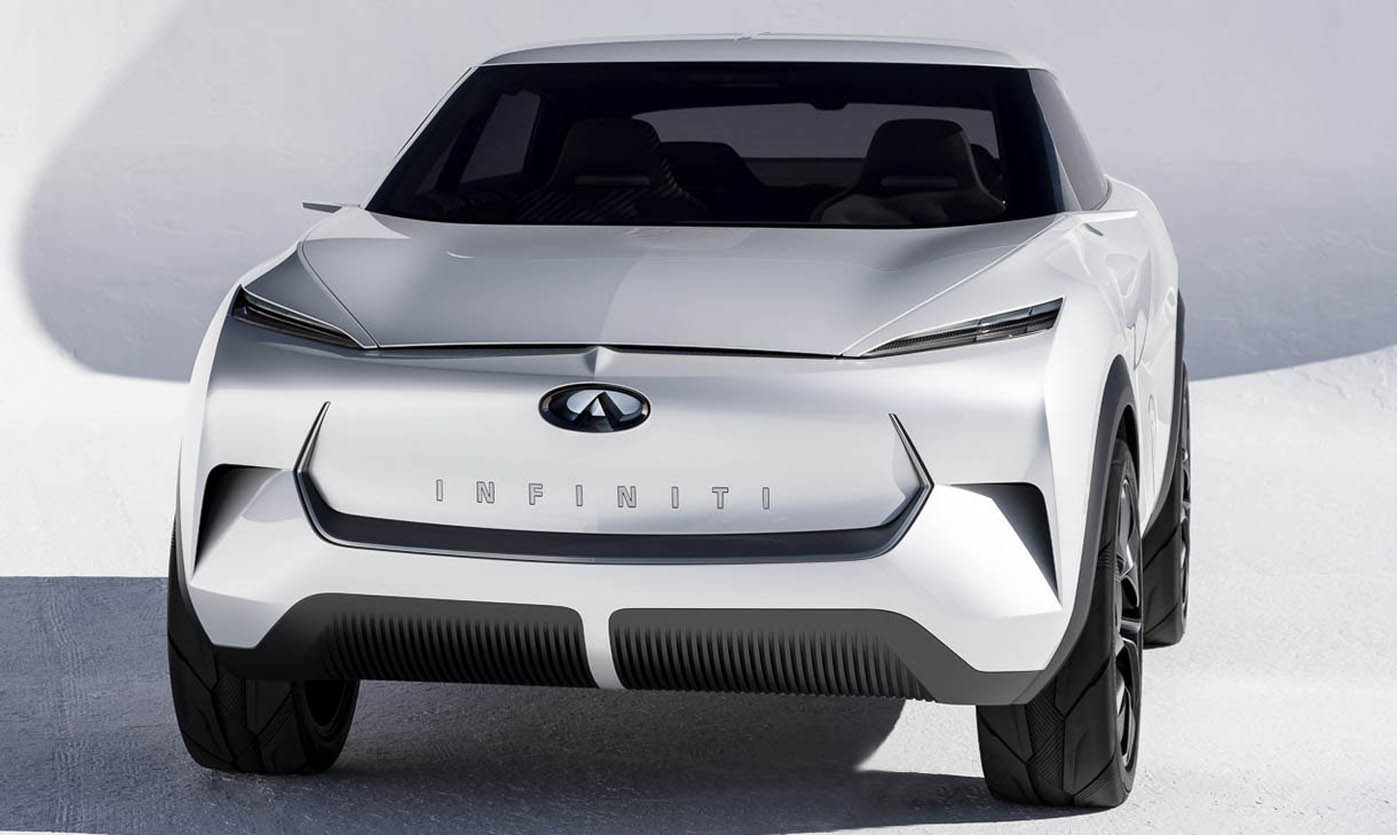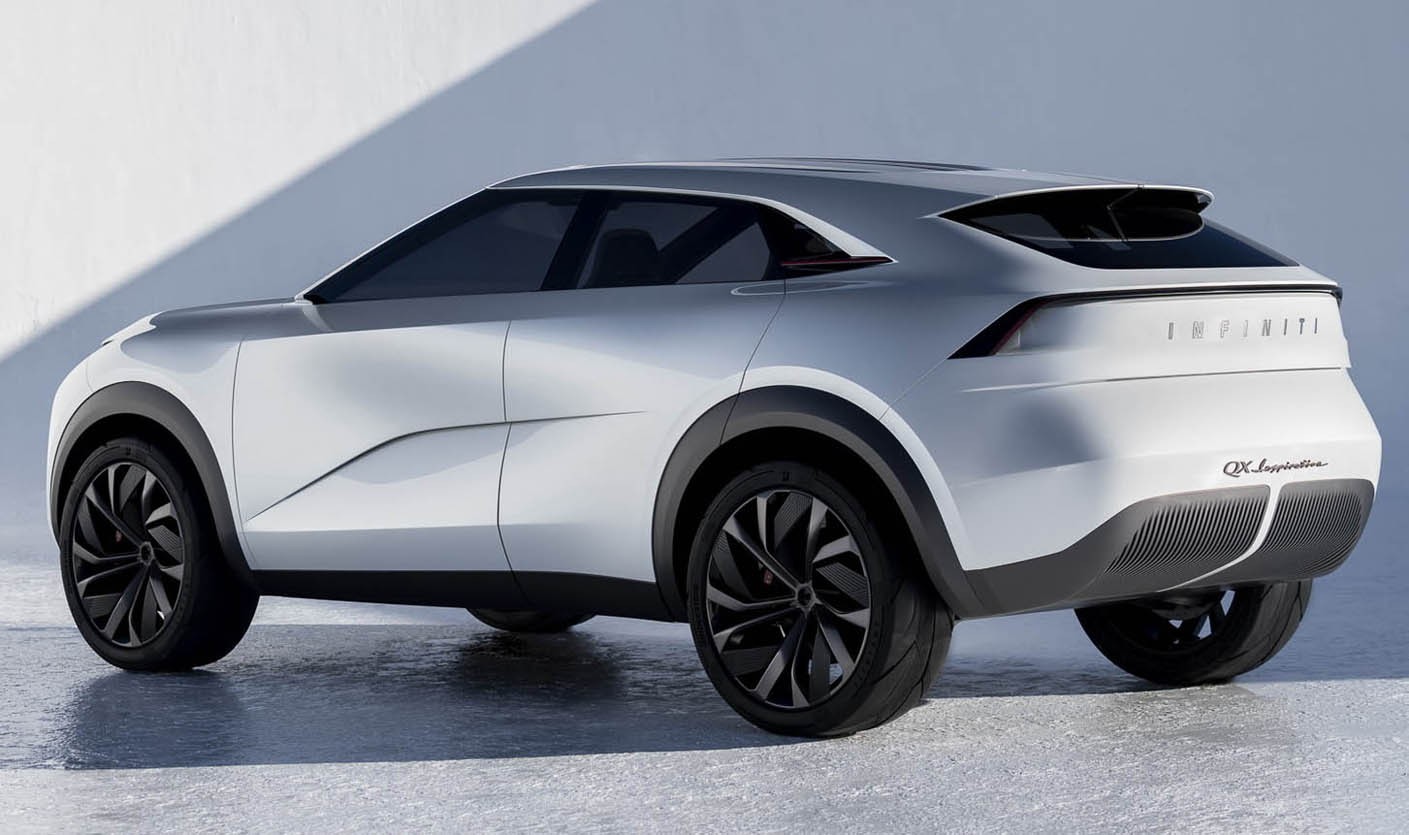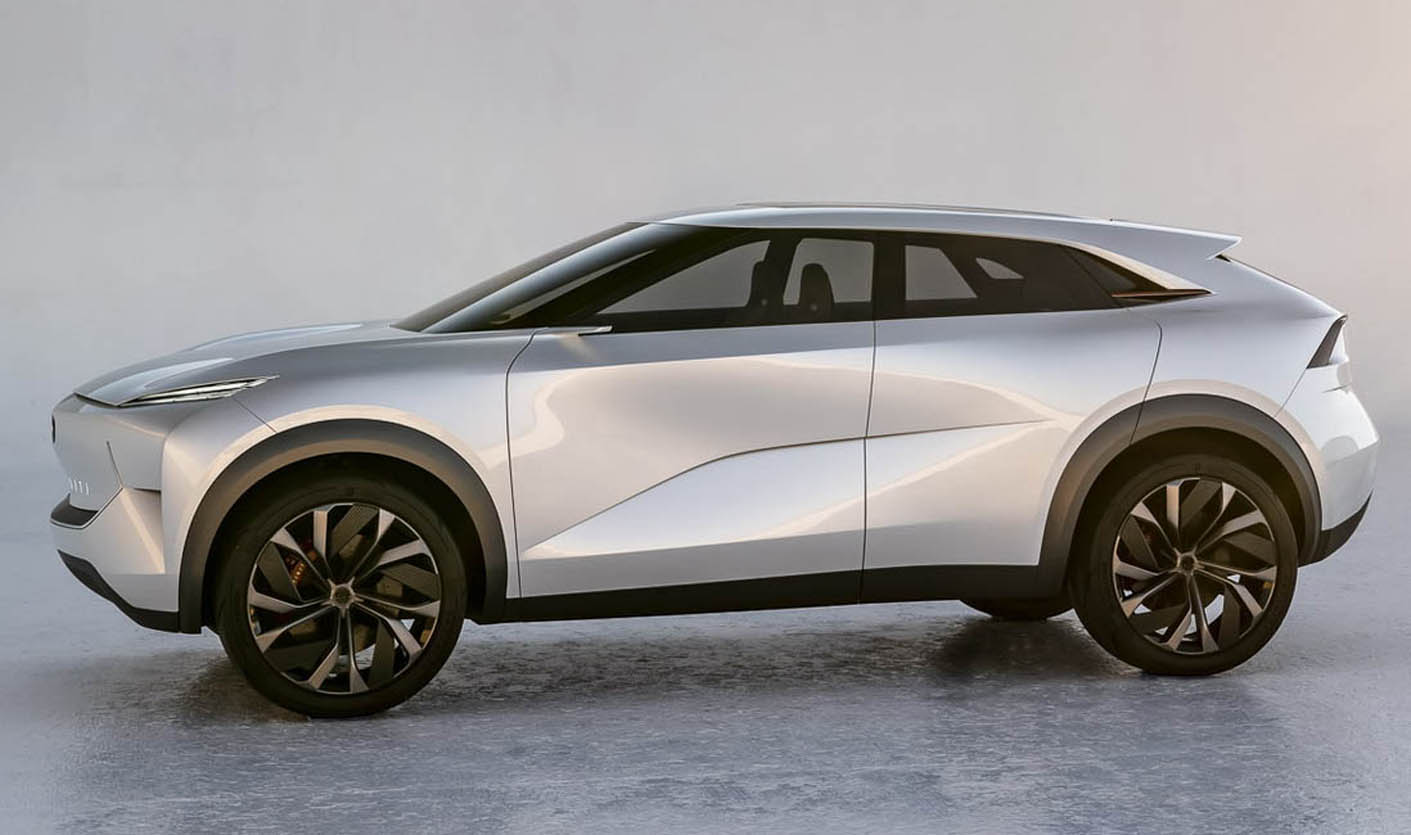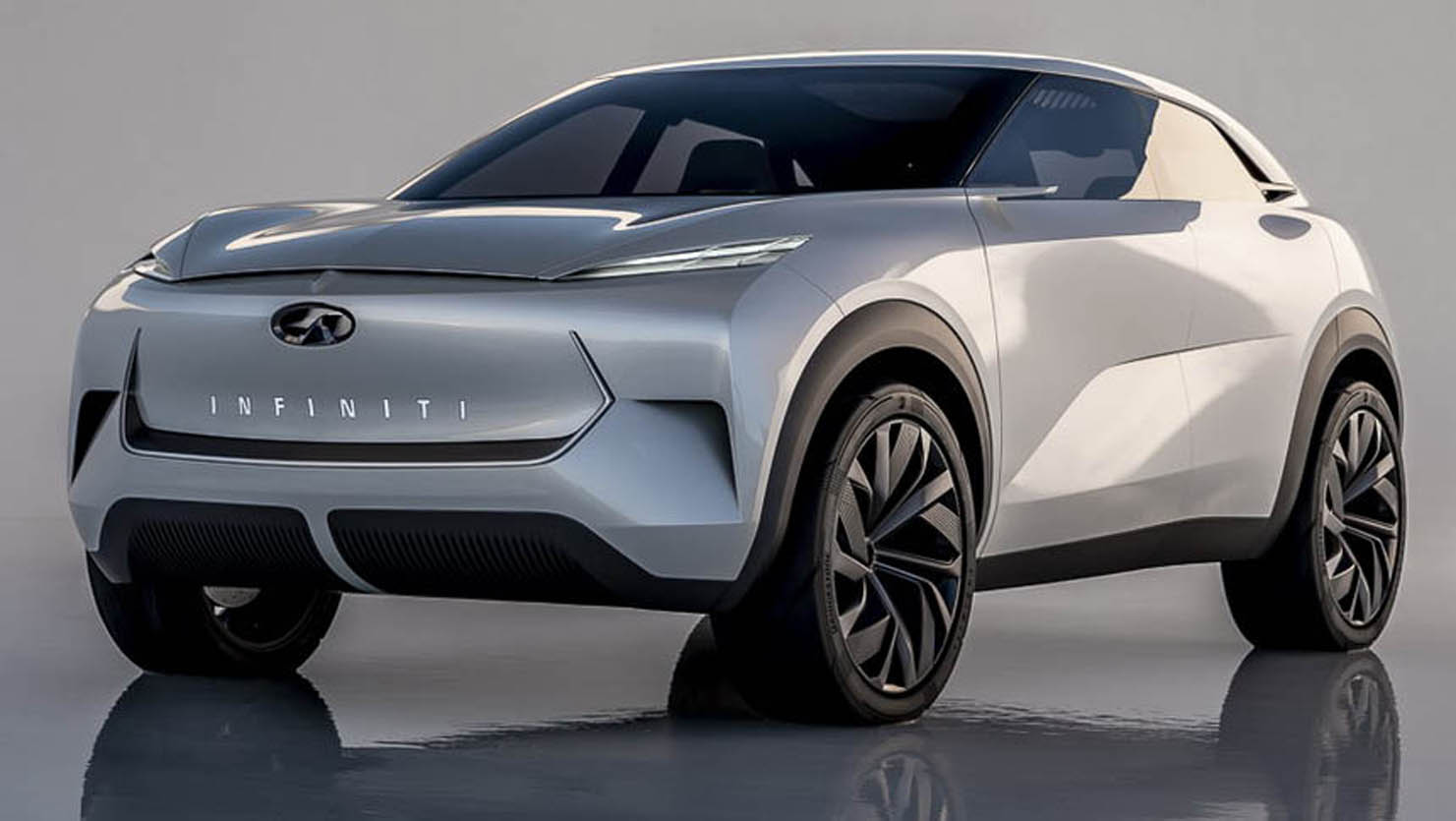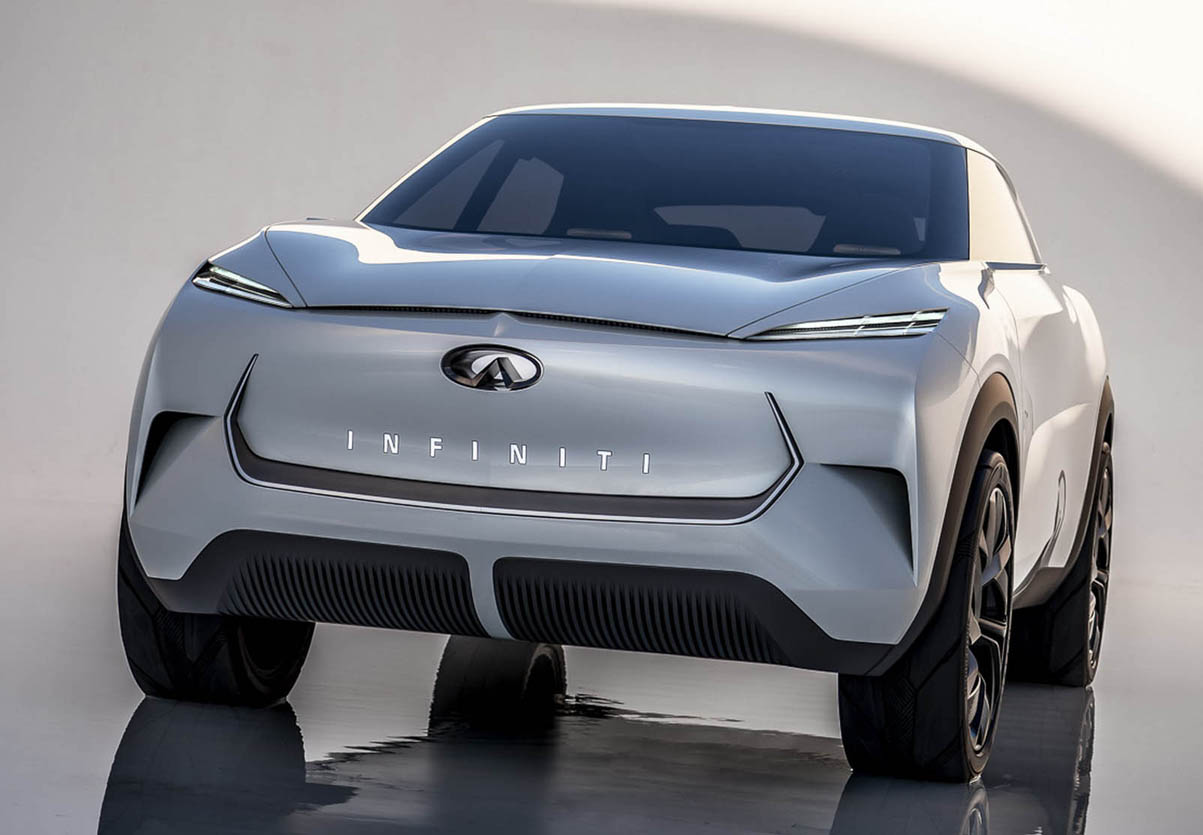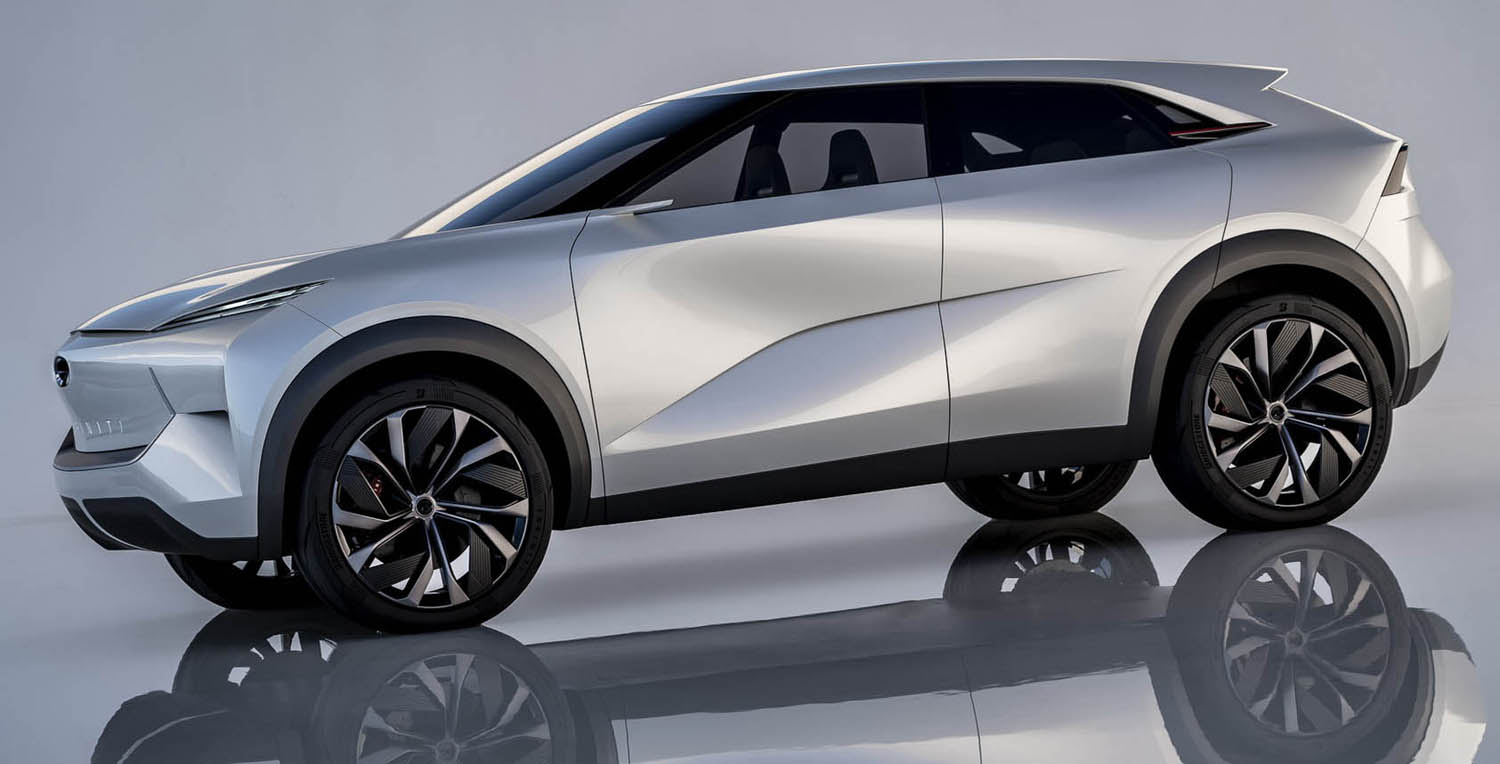
The Infiniti QX Inspiration is a mid-sized SUV concept previewing the brand’s first fully-electric vehicle. As a company with technological and powertrain innovation at its core, electrification is a natural next step for Infiniti, and the design study previews the brand’s plan to launch a range of high-performance electrified vehicles which promise an engaging drive and deliver range confidence. The Infiniti line-up of the future will consist of a range of electric, e-POWER and performance hybrid vehicles.
The Infiniti QX Inspiration signals a new era for Infiniti design enabled by technology, with a form language hinting at the potency and character of electrified powertrains. The new concept sets a direct precedent for the company’s first fully-electric production car, illustrating how new architectures and technologies are influencing modern Infiniti design. It also draws on the Japanese spatial concept of ‘Ma’, demonstrating how open spaces between lines create tension and builds anticipation.
This Japanese DNA continues into the cabin. The interior of QX Inspiration is hand-crafted using traditional techniques and a choice of materials inspired by a subtle Japanese sensuality. The development of new electrified vehicle platforms enables the creation of spacious, lounge-like interiors influenced by ‘omotenashi’, the Japanese approach to hospitality. Providing a seamlessly enabling and instinctive experience, the cabin incorporates technologies to create a welcoming environment, while assisting drivers and connecting occupants to the world around them.
Previewing Infiniti’s first fully-electric vehicle
The Infiniti QX Inspiration concept sets a direct precedent for the brand’s first fully-electric car: a high-performance SUV offering total range confidence. Electrification is a natural next step for the company, and, as a member of the Renault-Nissan-Mitsubishi Alliance – the industry leader in low- and zero-emission vehicles – a range of ultra-low emissions technology is available to Infiniti.
Infiniti’s future models will offer drivers a mixture of fully-electric, e-POWER and performance hybrid vehicles. These powertrains will be matched with dedicated platforms and vehicle architectures, delivering the high performance, complete range confidence and low environmental impact that buyers are coming to expect from premium car manufacturers.
High performance electrified all-wheel drive powertrain
With the planned electrification of Infiniti’s future product portfolio, the QX Inspiration signals the brand’s intention to produce a fully-electric mid-sized SUV, based on an all-new vehicle platform which could accommodate a powerful electric all-wheel drive (e-AWD) system. The concept’s SUV packaging means the high-capacity battery pack can be located below the vehicle floor, feeding power to a pair of electric motors (one on each axle).
The future Infiniti products promise a power delivery which is instantaneous, with the e-AWD system enabling blistering off-the-line acceleration. Power is distributed intelligently between all four wheels, and the battery’s location ensures a low center of gravity, meaning the QX Inspiration inspires confidence in all situations – from high-speed corners to long-distance cruises – and weather conditions.

Exterior design
The Infiniti QX Inspiration signals a new era for Infiniti design, influenced by new powertrain technologies and architectures. The form language of the new concept car hints at the potency and character of the brand’s future electrified powertrains.
A reference point for the new SUV concept was the 2018 Q Inspiration sedan concept, which signaled Infiniti’s first steps towards establishing a new design language characterized by straight lines, precise forms for functional elements, and clean surfaces. More technical in its design than any prior Infiniti, the Q Inspiration sedan combined simplicity with muscularity, inspired by modern powertrain technologies. Now, the 2019 QX Inspiration takes this further, echoing the sedan concept’s muscular form language while adopting certain details which first featured on the Prototype 9 and Prototype 10 design studies.
The QX Inspiration’s form language is characterized by straight lines and sudden creases, finely-balanced, smooth surfaces and organic shapes. This contrast gives the Infiniti QX Inspiration a new tonality compared to earlier Infiniti designs – it is muscular, yet composed; and less overtly aggressive, yet bold in its details.
Electrified by design
The design of the QX Inspiration – from its dimensions to its details – hint at the potency and character of Infiniti’s future electrified powertrains.
Infiniti’s earlier SUVs, such as the iconic 2003 FX, have been characterized by their long hoods – a nod to their powerful V8 and V6 internal combustion engines – and a cab-rearward silhouette. The QX Inspiration concept proposes its own uncompromisingly modern silhouette, inspired by its fully-electric powertrain. Without the need for a large engine, Infiniti’s designers adapted the proportions to accommodate a more balanced overall shape, a cab-forward design with short front and rear overhangs (855 mm and 945 mm, respectively) and a shorter hood. The concept’s overall length is 4,650 mm.
Locating the powertrain low down in the body and between the axles (2,850 mm apart) enabled Infiniti’s designers to create a bold and powerful lower body, blending its smooth, expansive surfaces with fascinating new proportions. The sleek, long roofline peaks at 1,630 mm in height, at a point directly above the front row of seats, then flows downwards into the car’s aerodynamically efficient Kammtail rear.
Without the need for a large front grille to cool an engine, the Infiniti QX Inspiration nonetheless retains shapes that define what would have been an air intake. The smooth surfaces replacing the grille feature an illuminated Infiniti logo, book-ended by channels that divert air over and around the body. A closer look at the thin headlamp strips reveal laser-like etchings, with a highly technical pattern echoed throughout the interior and exterior. The pattern also features in the wing-shaped light strip that spreads across the tailgate, adding a clean trailing edge to the rear of the car. Housed within wheelarches clad in contrasting black protective material are 22-inch wheels that feature a similar louvered pattern and an aerodynamic design to divert air along the flanks of the car.
The QX Inspiration hints at a developing Infiniti design signature. Sitting in the sharply-angled D-pillar is a vermilion signature line emboldened with a gold highlight. Surrounding it is a stylish quarterlight, which enhances the cab-forward profile.
Japanese DNA: designers inspired by Japanese design and architecture
Perhaps more so than any Infiniti created during the company’s 30-year existence, the QX Inspiration concept explores and actively draws upon the company’s Japanese roots.
Underpinning the aesthetic of the exterior is the Japanese spatial concept of ‘Ma’ – the mastery of empty space. For Infiniti’s designers, this meant adopting an approach which focused on the open space between the concept’s lines. To achieve this mastery of open space, the brand’s designers were drawn to the character of paper and the Japanese art of paperfolding, origami. Infused with Japanese DNA, the elegant exterior of the Infiniti QX Inspiration is derived from the artistic coaxing, folding and slicing of paper into different shapes.
The concept’s sharp lines and modern aesthetics are enhanced by a series of high-precision details, formed of a pattern repeated throughout the exterior and interior. The pattern is made up of thin lines and arranged into near-perpendicular forms, a modern interpretation of the historic architectural design of Japanese timber louvers used in construction. Traditional by nature, yet increasingly adopted in contemporary Japanese architecture, the louver-inspired lines appear in the front and rear lamps and on the surface of the 22-inch alloy wheels. Furthermore, the roof of the QX Inspiration is formed of louvered slats made of Japanese red cedar (or ‘sugi’), giving occupants a stunning view of the sky above and lending a sense of Japanese architectural modernity to the exterior.
Further reference to the car’s Japanese DNA can be found in the three colors used across the exterior. The QX Inspiration is finished in Liquid White pearlescent paint, inspired by the winter snows of Mount Fuji. In addition, highlights on the D-pillar and wheels are finished with two new signature color treatments, gold and vermilion – inspired by Japanese urushi lacquerware and gold kintsugi ceramic work.
Vermilion – a soft, warm shade of red – was widely used in traditional Japanese lacquerware. If lacquered ceramics were broken, they were often reformed with the kintsugi technique: that of repairing broken pottery with lacquer mixed with powdered silver, gold or platinum. Together, vermilion and gold were often used in painted Japanese artwork to express the power and energy of the sun.
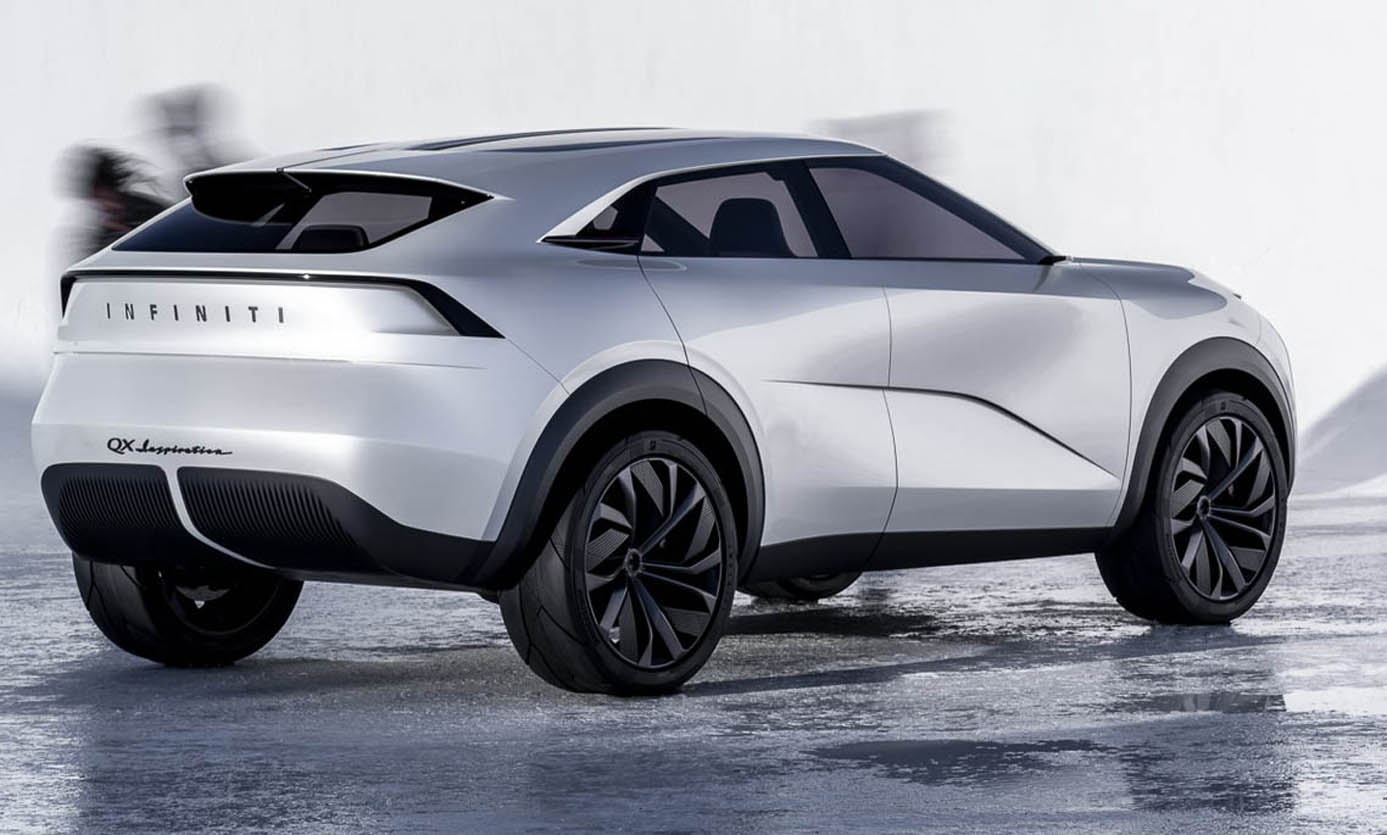
Interior design
The interior of the Infiniti QX Inspiration concept shows the potential for new electric vehicle platforms. Powered by a battery pack stored beneath the floor, with electric motors on each axle, there is no intrusion from driveshafts or transmission tunnels. The result is a spacious, lounge-like space, with flat floors and greater room for occupants and luggage.
The spaciousness enables the car’s human-centered ergonomics and creates a welcoming, open atmosphere that invites occupants to relax in comfort. The cabin has a level of architectural modernity to it, with a highly structural layout that diverges from conventional automobile design. Like the exterior, the interior of the QX Inspiration draws upon Infiniti’s devotion to the Japanese spatial concept of ‘Ma’, which has meant a close consideration of the surfaces and open spaces as much the layout and design of seats, dashboard and driver controls.
Dominating the dashboard is a wide-screen monitor flowing from pillar to pillar and finished in polarized gold-tinted glass. The rectangular steering wheel, trimmed in soft brown and white leather, also features its own monitor. In place of a transmission tunnel, graceful arches, trimmed in brown leather, rise out of the floor beneath the dashboard, flowing into a Bianco Carrara marble center console which extends to the rear seats.
The instrument panel is trimmed in a luxurious grey cloth normally used to upholster furniture and finished with Infiniti’s patented ‘dot quilting’ effect. Inspired by classic buttoned leather sofas, dot quilting produces a more informal interpretation of the diamond lozenge shape that gives classic Chesterfield lounge chairs their distinctive appearance. The idiosyncratic cloth extends from the front of the cabin and transitions into relaxing sofa-style rear seating area, generously proportioned for two passengers.
As seen from the outside, the headlining of the car is replaced by a unique timber louver structure, inspired by Japanese architecture. Creating pleasant indirect lighting for occupants, the sugi cedar structure casts beautiful shadows throughout the cabin as the car moves. As the individual slats twist outwards, the wood gives way to white exterior painted surfaces.
The most open surface of all, the flat floor receives its own unique treatment. Upholstered in white suede panels in a variety of rhomboid shapes, it features kintsugi gold inlays, adding an additional element of lounge design to the cabin.
Technology that enables
The QX Inspiration concept uses technologies to create a welcoming environment – one that assists drivers and connects occupants. Infiniti’s designers were influenced by the entirely natural coalescence of technology, hospitality and warm minimalism that is unique to Japan. They focused on developing a car which seamlessly and intuitively ‘enables’ occupants, both through the application of its technologies and by creating a comfortable, relaxing and natural atmosphere.
Following the principle of ‘omotenashi’, the notion of Japanese hospitality, the interior draws occupants in from the moment the doors open. Illuminations in the base of the coach doors cast a subtle light over the ground, echoing the same thin line pattern found throughout the car, rolling out an inviting ‘carpet’ of light. The front seats rotate 30 degrees outwards, making for easier ingress and egress.
Where the electric vehicle architecture is a macro-enabler for the overall structure and design, the pillar-to-pillar widescreen serves as a micro-enabler for the minimalist interior. A signature theme that will eventually be reflected in future Infiniti vehicles, the widescreen system has facilitated a dramatic reduction in the number of buttons in the interior and a clearer dashboard-wide display of information for driver and front passenger. The customizable screens enable the front passenger to see and control a range of functions, from infotainment to cabin lighting, as well as heating and ventilation.
The proliferation of displays – including in the center of the ‘widescreen’ rectangular steering wheel – gives the driver easy access to important information. There are digital displays linked to the rear-facing door-mounted cameras, as well as to navigation and traffic systems and vehicle diagnostics.
The center console transitions subtly from Bianco Carrara marble into a display surface at the base of the dashboard, creating a harmonic contrast between function and material form.
Infiniti has harnessed its autonomous drive technologies to further enhance the lounge-like atmosphere of the cabin. The steering wheel, pedals and driver displays maintain the all-important connection to driving – a feature which will remain common to all Infiniti vehicles for the foreseeable future. Yet, hinting at the full range of autonomous drive technologies that may one day be available, the steering wheel collapses into the dashboard and the pedals retract into the floor, releasing even more space should the driver wish to hand control over to the vehicle.
By contrast, the rear of the cabin is devoid of all technology, save for the Infiniti QX Inspiration’s lighting, a deliberate move by Infiniti’s designers to create a relaxing, screen-free space where occupants can sit back and watch the world go by.
Staying true to Infiniti’s Japanese roots
The artistic, hand-crafted interior of the QX Inspiration concept – and the choice of materials used – is inspired by a subtle Japanese sensuality. With technology central to its appeal as a lounge-like space, the careful selection of natural materials and soft colors found in the cabin has its roots in a uniquely Japanese appreciation of nature and craftsmanship.
The Bianco Carrara marble center console is a defining feature. While the material itself is European, the stone texture is reminiscent of Japanese artistic sensibilities, fusing technology in the front of the cabin with a more natural, authentic appearance. At the end of the marble table between the two rear seats sits a branch of ‘ume no hana’ plum blossom. This blossom is associated in Japan with the notion of ‘omotenashi’ hospitality and welcoming guests into the home. It is typically the first to flower in the spring, as the temperature warms up after winter.
This appreciation of spring is echoed further in the choice of colors that define the cabin’s soft ambient lighting and graphic displays. Flooding the cabin in a calming glow, the lighting takes on one of four colors – ‘wakanae’ (a soft green, like new spring grass); ‘torinoko’ (a pale yellow, and the same shade as a hen’s egg); ‘akebono’ (the subtle pinks and reds of a breaking dawn); and ‘shirafuji’ (the soft purple of Japanese wisteria blossom). The subdued tones of the graphic displays and lighting perfectly complement the soft greys, browns and whites of the interior’s upholstery.
The roof – finished in ‘sugi’, Japanese red cedar wood – further ties the cabin of the Infiniti QX Inspiration to its natural roots. Adhering to the Japanese world-view of ‘wabi-sabi’, that of accepting imperfections, Infiniti’s designers have left the knot and grain of the wood on display, expressing the strength and life of the raw material. Traditional in its design origins, the roof is distinctly modern in its structure and appearance. Beneath, the white suede floor adopts ‘kintsugi’ gold inlay between panels, further instilling the car with a degree of Japanese sensuality and craft tradition.
